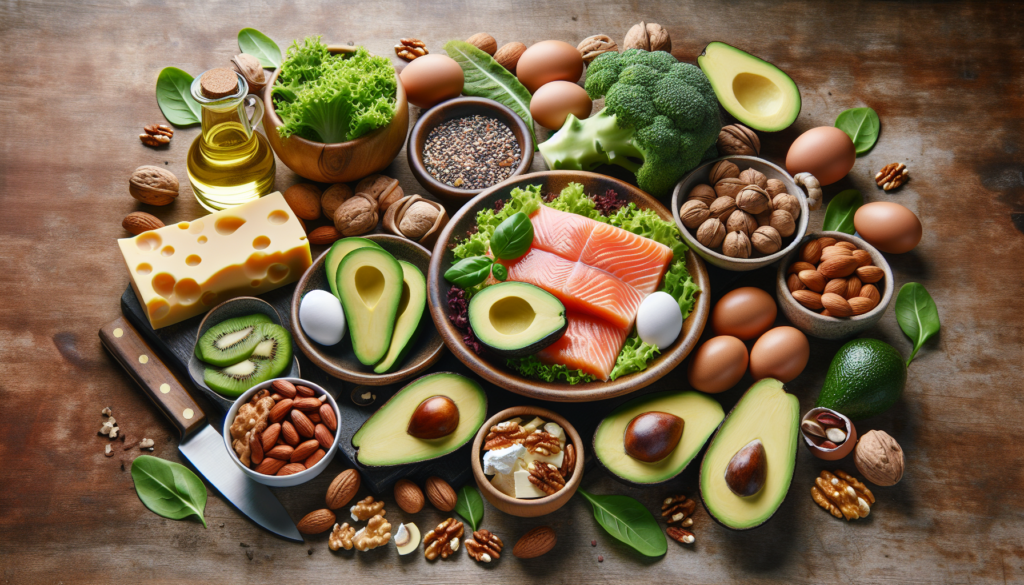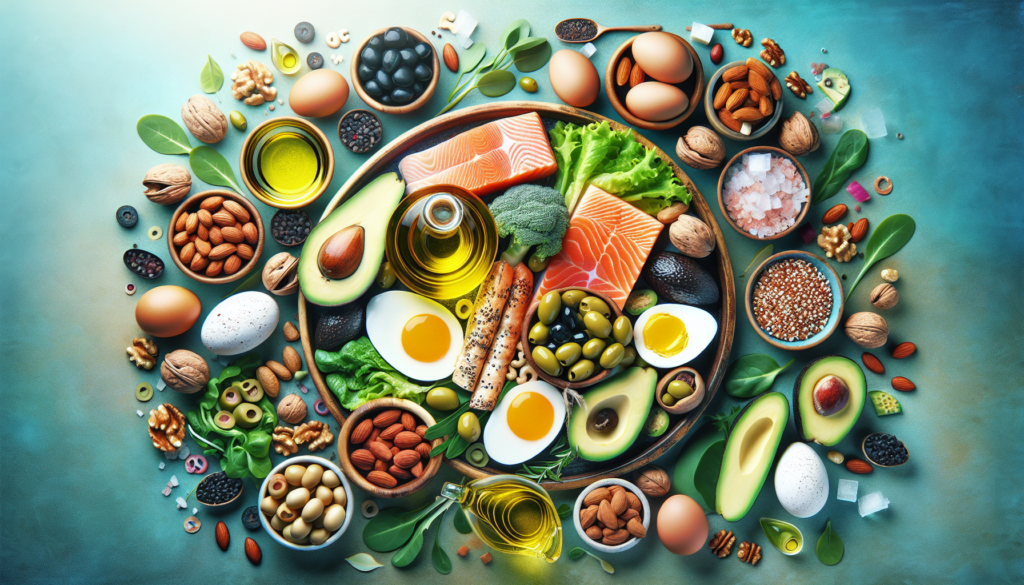So you’ve heard about the Keto diet and you’re curious to know what it’s all about. Look no further! This article serves as your ultimate guide to Keto, providing you with all the information you need to understand and embark on this popular low-carb, high-fat diet. From the science behind ketosis to tips on meal planning and recipe ideas, we’ve got you covered. Let’s delve into the world of Keto and discover how it can help you achieve your health and weight loss goals.
What is the Keto Diet?
Introduction to the Keto Diet
The Keto Diet, short for the ketogenic diet, is a low-carb, high-fat diet that has gained popularity in recent years for its potential to aid in weight loss and improve overall health. This diet involves drastically reducing your carbohydrate intake and replacing it with healthy fats. By doing so, your body enters a state called ketosis, where it uses fat as its primary source of fuel instead of glucose from carbohydrates.
How Does the Keto Diet Work?
The Keto Diet works by forcing your body into a metabolic state called ketosis. Normally, your body relies on carbohydrates for energy. However, when you significantly reduce your carb intake, your body starts to burn stored fat for fuel instead. This leads to weight loss and various other health benefits.
Benefits of the Keto Diet
The Keto Diet offers numerous benefits beyond weight loss. Some of the key advantages include improved mental clarity and focus, increased energy levels, reduced inflammation, and better blood sugar control. This diet may also help manage certain medical conditions such as epilepsy, polycystic ovary syndrome (PCOS), and type 2 diabetes.
Risks and Side Effects of the Keto Diet
While the Keto Diet is generally safe for most people, it may have certain risks and side effects. Some common side effects include “keto flu,” which involves fatigue, headache, and irritability as your body adjusts to using fat as fuel. Additionally, the diet may lead to nutritional deficiencies if not followed properly. It is important to consult with a healthcare professional before adopting the Keto Diet, especially if you have any underlying health conditions.
Getting Started with the Keto Diet
Understanding Macronutrients
To successfully follow the Keto Diet, it is crucial to understand macronutrients. Macronutrients refer to the three major nutrients that your body needs for energy: carbohydrates, fats, and proteins. On the Keto Diet, you will significantly decrease your carb intake, increase your fat intake, and consume a moderate amount of protein.
Calculating Your Macros
Calculating your macros is an essential step in getting started with the Keto Diet. To determine the ideal macronutrient ratios for your body, you can use various online calculators or consult with a registered dietitian. The typical macro breakdown for the Keto Diet is around 70-75% of calories from fat, 20-25% from protein, and 5-10% from carbohydrates.
Foods to Include on a Keto Diet
A well-rounded Keto Diet includes a variety of healthy and nutrient-dense foods. Some examples of foods to include are avocados, nuts and seeds, fatty fish, low-carb vegetables, grass-fed meat, pasture-raised eggs, and full-fat dairy products. These foods are rich in healthy fats, quality proteins, and essential vitamins and minerals.
Foods to Avoid on a Keto Diet
To maintain ketosis, it is important to avoid certain foods that are high in carbohydrates and sugar. Some foods to avoid on the Keto Diet include bread, pasta, rice, sugary beverages, processed snacks, and most fruits. It is essential to read food labels carefully and be mindful of hidden sources of carbs.
Tips for Meal Planning and Prepping
Meal planning and prepping can greatly simplify the Keto Diet and help you stay on track. Plan your meals in advance, focusing on a balance of fats, proteins, and low-carb vegetables. Batch cooking and preparing meals in advance can save time and ensure that you always have a healthy, keto-friendly option readily available.

Entering Ketosis
What is Ketosis?
Ketosis is a natural metabolic state in which your body starts to burn stored fat for fuel instead of glucose. During ketosis, ketones are produced as a byproduct of fat metabolism. These ketones serve as an alternative fuel source for your brain and body.
Signs and Stages of Ketosis
There are certain signs that indicate your body has entered ketosis. These signs may include increased energy, decreased appetite, mental clarity, and weight loss. Ketosis has different stages, with deeper ketosis resulting in higher ketone levels in your blood.
Measuring Ketone Levels
To determine whether you are in ketosis, you can measure your ketone levels using various methods. The most common methods include urine test strips, blood ketone meters, and breath ketone analyzers. These tools can provide an indication of the level of ketosis your body is experiencing.
How to Enter Ketosis
To enter ketosis, you need to restrict your carbohydrate intake to a very low level, typically around 20-50 grams per day. This will deplete your body’s glycogen stores and force it to rely on fat for fuel. Additionally, consuming moderate amounts of protein and increasing your intake of healthy fats is important to support ketosis.
Common Mistakes to Avoid
When attempting to enter and maintain ketosis, it is important to avoid common mistakes that can hinder your progress. Some common mistakes include consuming hidden carbs, not drinking enough water, not consuming enough fat, and overeating protein. It is important to educate yourself on the Keto Diet and seek guidance from a healthcare professional or registered dietitian to avoid these pitfalls.
Designing Your Keto Meal Plan
Determining Your Calorie Needs
To design an effective Keto Meal Plan, it is essential to determine your calorie needs based on your activity level, age, gender, and overall goals. There are online calculators and equations that can help you estimate your calorie needs. Once you have the total calorie target, you can allocate the appropriate macronutrients.
Choosing the Right Fat Sources
The Keto Diet relies heavily on healthy fats as the primary source of energy. It is important to choose high-quality fat sources that are rich in monounsaturated and polyunsaturated fats. Examples of healthy fat sources include avocados, olive oil, coconut oil, nuts, seeds, and fatty fish.
Selecting Protein and Carbohydrate Sources
Protein should be consumed in moderate amounts on the Keto Diet. It is important to choose lean sources of protein such as chicken, turkey, lean beef, and fish. When it comes to carbohydrates, low-carb vegetables should be prioritized, as they provide essential vitamins and fiber while keeping carb intake low.
Creating Balanced and Nutritious Meals
To create balanced and nutritious meals, aim for a combination of healthy fats, lean proteins, and low-carb vegetables. Some meal ideas include grilled salmon with asparagus, avocado and bacon salad, and cauliflower rice stir-fry with tofu.
Incorporating Keto-Friendly Snacks
Snacking can be a part of the Keto Diet as long as you choose snacks that are low in carbs and high in healthy fats. Some examples of keto-friendly snacks include nuts, seeds, cheese, nut butter, and hard-boiled eggs. It is important to read food labels and be mindful of portion sizes.
Planning for Dining Out
Dining out on the Keto Diet can be challenging, but with proper planning, it is possible to make keto-friendly choices. Look for restaurants that offer grilled protein options and substitute high-carb sides with vegetables. Additionally, be mindful of sauces and dressings that may contain hidden sugars and carbs. Asking for modifications and being clear about your dietary preferences can help ensure a successful dining experience.

Following the Keto Diet on a Budget
Tips for Affordable Keto Shopping
Following the Keto Diet doesn’t have to break the bank. To shop for keto-friendly foods on a budget, focus on buying seasonal produce, purchase in bulk, and seek out sales and discounts. Additionally, buying lower-cost cuts of meat and opting for frozen vegetables can help save money.
Budget-Friendly Keto Recipes
There are plenty of budget-friendly recipes that can be enjoyed on the Keto Diet. Simple dishes like scrambled eggs with vegetables, tuna salad lettuce wraps, and cauliflower fried rice are easy to make, delicious, and won’t empty your wallet. Online resources and cookbooks dedicated to budget-friendly keto recipes can provide inspiration and ideas.
Meal Prep for Cost Savings
Meal prepping is not only a time-saving strategy but can also help save money when following the Keto Diet. By batch cooking and portioning out your meals in advance, you can avoid the temptation of eating out or ordering expensive takeout. Additionally, repurposing leftovers and using them creatively in other dishes can help reduce food waste and stretch your budget.
Utilizing Seasonal Produce
Incorporating seasonal produce into your Keto Diet can be cost-effective and nutritious. Seasonal produce tends to be less expensive and often tastes better. Plan your meals around the fruits and vegetables that are in season and take advantage of local farmers markets and community-supported agriculture (CSA) programs for affordable options.
Managing Keto Flu and Common Challenges
What is Keto Flu?
Keto flu refers to a collection of symptoms that some people may experience when transitioning to the Keto Diet. These symptoms are typically temporary and include fatigue, headache, irritability, nausea, and muscle cramps. It is important to note that not everyone will experience keto flu, and the severity and duration can vary.
Symptoms and Duration of Keto Flu
The symptoms of keto flu typically resemble those of the flu and can last anywhere from a few days to a couple of weeks. Symptoms may include fatigue, headache, brain fog, irritability, digestive issues, and dizziness. It is important to listen to your body and give it time to adjust during this transition period.
Tips for Preventing and Alleviating Keto Flu
While keto flu cannot be completely avoided, there are steps you can take to minimize its impact. Staying hydrated, replenishing electrolytes, getting enough sleep, and consuming enough fat can help prevent or alleviate symptoms. Additionally, gradually reducing your carb intake rather than making a sudden drastic change can also help ease the transition.
Dealing with Cravings and Food Temptations
Cravings and food temptations can be a challenge when following the Keto Diet. To manage cravings, it is important to ensure your meals are satisfying and include enough healthy fats. Incorporating low-carb snacks and keto-friendly treats in moderation can also help curb cravings. Cravings may diminish over time as your body adapts to the Keto Diet.
Overcoming Social and Lifestyle Challenges
The Keto Diet can present social and lifestyle challenges, especially in social settings or when dining out with friends and family. It is important to communicate your dietary needs and goals with those around you. Educate yourself on keto-friendly options and alternatives. Being prepared, flexible, and proactive can help you navigate social situations while staying committed to your Keto Diet.
Supplements for the Keto Diet
Understanding the Role of Supplements
While the Keto Diet can provide most of the nutrients your body needs, certain supplements may be beneficial, especially during the initial stages of the diet. Supplements can help support your overall health, fill in any potential nutrient gaps, and aid in managing specific symptoms or challenges.
Essential Supplements for the Keto Diet
Some essential supplements for the Keto Diet include electrolytes, such as magnesium, potassium, and sodium, to replenish electrolyte levels. Omega-3 fatty acids can also be beneficial for heart health and inflammation reduction. It is important to consult with a healthcare professional before starting any new supplements.
Optional Supplements for Enhanced Performance
Optional supplements for enhanced performance on the Keto Diet include exogenous ketones and MCT oil. Exogenous ketones can provide a boost of energy and promote ketosis, while MCT oil can increase fat intake and help support ketone production. These supplements may be beneficial for athletes or individuals aiming to maximize their performance.
Potential Risks and Considerations
When considering supplements, it is important to be aware of potential risks and considerations. Some individuals may experience digestive discomfort or other adverse effects from certain supplements. Additionally, supplements are not a substitute for a well-rounded diet and should be used in conjunction with a healthy lifestyle.
Exercise and the Keto Diet
Benefits of Exercise on the Keto Diet
Incorporating exercise into your Keto Diet can provide numerous benefits. Regular physical activity can help support weight loss, improve overall fitness, boost mood and mental well-being, and increase insulin sensitivity. Exercise can also help preserve muscle mass and prevent muscle loss while on a low-carb diet.
Choosing the Right Types of Exercise
Different types of exercise can be beneficial on the Keto Diet. Incorporating a mix of cardiovascular exercises, such as walking, jogging, or cycling, and strength training exercises can help promote overall fitness and fat loss. Experiment with different activities to find what you enjoy and what works best for your body.
Timing Your Workouts
Timing your workouts can have an impact on your exercise performance and fuel utilization. Some individuals prefer exercising in a fasted state, as it can help promote fat burning. Others may find it beneficial to consume a small meal or snack prior to their workout for increased energy. Experiment with different approaches to find what works best for you.
Optimizing Performance and Recovery
To optimize your exercise performance and support recovery on the Keto Diet, it is important to prioritize adequate hydration, replenish electrolytes, and consume enough healthy fats for sustained energy. Additionally, listening to your body, getting enough rest and sleep, and practicing proper post-workout nutrition can help maximize your results.
Combating Exercise-Induced Carb Cravings
Exercise-induced carb cravings can be a challenge on the Keto Diet, especially during intense or prolonged workouts. To combat these cravings, try incorporating a small amount of targeted carbohydrates before or during your workout, such as from a piece of fruit. This can provide a quick source of energy without derailing your ketosis.
Tracking Progress and Adjusting Your Approach
Monitoring Weight Loss and Body Composition
When following the Keto Diet, it is important to monitor your progress beyond just weight loss. Tracking your body composition, including muscle mass and body fat percentage, can provide a more accurate reflection of your overall health and progress. Utilize tools such as body measurements, progress photos, and body composition scales to track changes.
Measuring Ketone Levels and Glucose
In addition to monitoring weight loss and body composition, tracking your ketone levels and glucose can provide insight into your body’s state of ketosis. You can measure ketone levels through various methods, such as blood ketone monitors or breath ketone analyzers. Monitoring your glucose levels can help ensure stable blood sugar control.
Adjusting Macros for Plateau-Busting
If you reach a weight loss plateau on the Keto Diet, it may be necessary to adjust your macronutrient ratios. Gradually decreasing your fat intake and increasing your protein intake can help stimulate weight loss. It is important to make these adjustments mindfully and consult with a healthcare professional or registered dietitian for guidance.
Reassessing Your Goals and Needs
As you progress on the Keto Diet, it is important to periodically reassess your goals and needs. Your body’s nutritional requirements and personal goals may change over time, and adjusting your approach accordingly can help ensure continued success. Regularly evaluating your progress and making necessary adjustments can help you stay motivated and achieve long-term success.
Sustaining Long-Term Success on the Keto Diet
Finding Balance and Sustainability
To sustain long-term success on the Keto Diet, it is important to find a balance that works for you. This may involve occasional flexibility in your diet, allowing for small indulgences or special occasions. Finding sustainable ways to enjoy your favorite foods within the principles of the Keto Diet can help prevent feelings of deprivation.
Maintenance Phase Guidelines
Once you have achieved your weight loss or health goals on the Keto Diet, transitioning to a maintenance phase is essential. During this phase, you can slightly increase your carbohydrate intake while still focusing on whole, nutrient-dense foods. Regularly monitoring your body’s response and adjusting your macronutrients accordingly can help maintain the desired results.
Transitioning Out of Ketosis
If and when you decide to transition out of ketosis, it is important to do so gradually and mindfully. Slowly reintroduce carbohydrates into your diet while monitoring your body’s response. Pay attention to how different foods affect your energy levels, mood, and overall well-being. Balancing your macronutrients and focusing on whole, unprocessed foods can support a healthy transition.
Incorporating Carb Cycling
Carb cycling is a strategy that involves alternating between high-carb and low-carb days or weeks. This approach can help prevent metabolic adaptation and support long-term sustainability. By strategically timing your higher-carb days around intense workouts or specific goals, you can optimize your performance and maintain a healthy relationship with carbohydrates.
Lifestyle Choices for Overall Health
The Keto Diet is just one aspect of a healthy lifestyle. To support overall health and well-being, it is important to incorporate other lifestyle choices such as regular physical activity, stress management techniques, adequate sleep, and hydration. Maintaining a well-rounded approach to health can help you achieve sustainable results and optimize your overall quality of life.
In conclusion, the Keto Diet is a low-carb, high-fat diet that can offer numerous benefits, including weight loss, improved mental clarity, and better blood sugar control. By understanding the principles of the Keto Diet, designing a personalized meal plan, managing challenges, and making sustainable lifestyle choices, you can successfully follow this diet and achieve your health and wellness goals. Remember to consult with a healthcare professional or registered dietitian before starting any new diet or exercise program.

Hi! My name is Linda, and I’m a health and fitness specialist. I’m passionate about helping people live their healthiest and happiest lives. In my articles I share my knowledge and experience on all things health and fitness. With a passion for writing and a deep understanding of the health and fitness landscape, Linda has established herself as a trusted authority in the field.